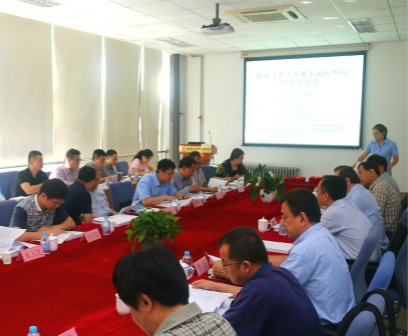China Instrument Network Instrument Research and Development On September 18, Steel Research and Testing Technology Co., Ltd. held a special national cross-border non-destructive testing instrument for cross-border goods at its Yongfeng Industrial Base. "Development and Application" project kick-off meeting.

With the “One Belt and One Road†national strategy and the rapid development of international trade, the number and types of customs clearance goods have increased rapidly. The customs clearance inspection tasks are arduous. The speed of laboratory inspections cannot meet the needs of import and export trade. At the same time, most of the existing rapid detection instruments have the problems of single detection parameters and low detection sensitivity, and it is difficult to meet the requirements of the new form. Faced with this demand, in order to make up for the inadequacies of existing port inspection technologies and improve the efficiency of customs clearance, the project team led by Steel Research and Testing Technology Co., Ltd. has submitted a report to the country for the development and application of multi-parameter nondestructive testing instruments for cross-border goods. Major projects for the development of major scientific instruments and equipment in 2017 and received support.
The project “Development and Application of Multiparameter Non-destructive Tester for Cross-border Goods†was recommended by the General Administration of Quality Supervision, Inspection and Quarantine, and led by Steel Research and Testing Technology Co., Ltd.; it began in July 2017 and ended in June 2021; the total budget 39.9 million yuan, including 18.9 million yuan in special funds for the central government; the project leader is Chen Jiwen, deputy general manager of Steel Research and Testing Technology Co., Ltd.; the project is divided into "single-wavelength all-focus high-sensitivity XRF detection module development" and "dual wavelength "Transient differential high signal-to-noise ratio Raman detection module", "multi-parameter non-destructive test equipment engineering and industrialization of cross-border goods" and other five topics; project participants also have China Academy of Inspection and Quarantine, Shenzhen Entry-Exit Inspection and Quarantine Bureau of Industrial Products Testing Technology Center, Tianjin Entry-Exit Inspection and Quarantine Bureau of Metals and Minerals Testing Center, China Inspection Guoyan (Beijing) Technology Co., Ltd., Beijing Entry-Exit Inspection and Quarantine Bureau Inspection and Quarantine Technology Center, Shandong Entry-Exit Inspection and Quarantine Bureau Inspection and Quarantine Technical Center, Shanghai Entry-Exit Inspection and Quarantine Bureau Industrial Products and Raw Material Testing Technology Center.
"Cross-Border Multi-parameter Nondestructive Detector" is based on the integration of single-wavelength all-focus XRF and dual-wavelength transient Raman spectroscopy to achieve simultaneous detection of molecular structure and element content. Among them, single-wavelength all-focus bending crystal XRF technology is used to improve the detection limit of low-level light elements; dual-wavelength transient differential Raman technology overcomes complex matrix fluorescence background interference and accurately extracts Raman weak signals; R&D of XRF and Raman isotopic focusing To compound the technology and eliminate the signal interference generated; to establish a fast, accurate, and highly sensitive detection method for multi-parameter on-site goods.
Liu Jinchang, Research Fellow, High Technology Research and Development Center, Ministry of Science and Technology, Zhao Liang, High Technology Research and Development Center, Ministry of Science and Technology; Project Responsibility Expert; Yang Zhijun, Associate Researcher, Chinese Academy of Metrology, Chinese Academy of Sciences, Shenyang Science Instrument Co., Ltd. Lei Zhenlin; Technical Expert; Academician, Chinese Academy of Engineering Prof. Hai Zhou, Researcher Liu Liping, Beijing CDC, Professor Li Yan, Tsinghua University, Director Ma Guoxue, Beijing Radiation Safety Technology Center, Ma Deling Senior Accountant, Beijing Heyi Accounting Firm, User Committee Member, Metals and Materials Testing Center, Tianjin Entry-Exit Inspection and Quarantine Bureau Hong Wei, researcher of National Institute of Traditional Chinese Medicine He Zuozhong, Yang Xiaobing, Inspection and Quarantine Technology Center of Beijing Entry-Exit Inspection and Quarantine Bureau, and Qu Wenjun, a member of the National Geotechnical Testing Center, were invited to attend the meeting.
Bao Lei, Secretary of Party Committee of Steel Research & Technology Co., Ltd. presided over the meeting. Liu Jinchang, a researcher at the High Technology Research and Development Center of the Ministry of Science and Technology, publicized the management guidelines and policies for the country's major scientific instrument and equipment development projects, and put forward clear requirements for project implementation. . According to the requirements of the special management measures, this meeting first established the "Project Overall Group", "Project Technology Team" and "Project User Committee" and issued letters of appointment. As the project leader, deputy general manager Chen Jiwen introduced the specific technical plan for the project implementation on behalf of the project team. Director Zhang Xiaoshuai of the project management office introduced the project management measures and submitted it to the General Assembly for consideration.
Leaders and experts at the meeting discussed and communicated on project implementation plans and organizational management methods, and made many meaningful suggestions for the project. Academician Wang Haizhou points out that the project needs to identify the unique application fields of XRF and Raman's co-location and focusing integration technology; the R&D stage is based on an internationalized platform, but the core components still have to be done by themselves; the application side, the production side, and R&D Fang Trinity, based on the needs of the user side R & D equipment, that is, the application of the first; the project's positioning for the special, screening equipment, the model should be a class of a class to do, and curing to the instrument.
(Original Title: Steel Research Nasal Takes Lead Major Project “Development and Application of Multiparameter Nondestructive Detector for Cross-border Goods†Start)
![<?echo $_SERVER['SERVER_NAME'];?>](/template/twentyseventeen/skin/images/header.jpg)